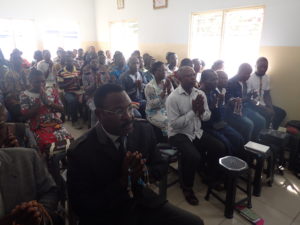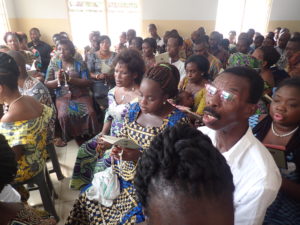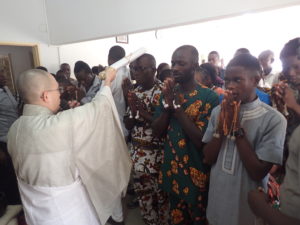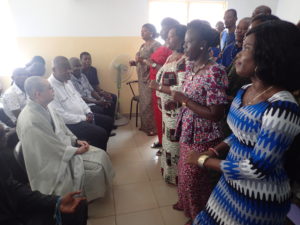
CHIEF PRIEST VISIT IN TOGO DISTRICT
GENERAL REPORT
From 24 to 27 January 2019
The District of Togo had the honor and the privilege to welcome Rev. Shindo Imafuku, Chief Priest of Hokkeji Temple, accompanied by Dr. Kwame Boamah, Koto of Hokkeji Temple. This visit forms part of the Chief Priest’s activities to assist Togo District achieve their district shakubuku for goal for 2019. The Chief Priest and Koto were received at the Togo-Ghana border on the afternoon of 24 January 2019 by the District Leader, Mr. Koffi Etékpo, accompanied by his Assistant District Leader, Mr. Mensan Ayena.
The delegation was taken to the Activity Center and then to the Hotel.

At 6 pm, Rév visited the Dagué subdistrict. The aim is to meet with members of this locality and to support their efforts in the propagation of the teachings of Nichiren Daishonin. The lecture of the Chief Priest was based on: “The Three (3) Poisons”, this meeting saw the participation of about twenty guests alongside the members of the Dagué subdistrict.
The following days, that is, 25, 26 and 27 January were devoted to shakubuku meetings in the cities of Atakpamé, Afagnan and Lomé (Activity Center).
Besides these shakubuku meetings, the Chief Priest performed the Frame Raising ceremony at the future Activity Center at Davié and the Leaders meeting. The construction of this center is essential for the propagation of Buddhism in Togo in the future.
The details of these meetings, including the participation and the number of Gojukai achieved are recorded in the following table.
| Dates | Towns | Distance from Lomé | Hours | Participation | Gojukai |
| 25-01-19 | Davié | 35 km | 9h-11h | 83 | 05 |
| Atakpamé | 160 km | 18h-20h | 79 | 19 | |
| 26-01-16 | Afagnan | 70 km | 9h-13h | 185 | 56 |
| 27-01-19 | Lomé | —— | 9h-13h | 411 | 39 |
| Total | 758 | 124 | |||
What to remember from all these meetings
1- The frame raising ceremony

This ceremony complemented that of laying stone. It devoted the progressive effort of Togolese members, including the diaspora in building this building for the propagation of Nichiren Buddhism. During the ceremony Chief Priest affirmed: “Your sincere contribution for this project and Gokuyo to the Hokkeji Temple are precious Buddhist practice for kosen-rufu activities in Togo and Africa. Therefore, you will be able to amass great benefit”
2- The leaders meeting
It took place in the evening of January 26, 2019 from 18h at the Activity Center. This meeting was attended by 26 leaders (Blocks, subdistricts, divisional and others).
Koto began by emphasizing on the following points:
- the importance of the home visitation;
- the importance of 1h Shodai in the blocks which must be inclusive;
- the participation of Oko ceremony;
- the Davié project which needs sincere contribution from all members. This project is be part of the preparations for the 25th Anniversary of the Hokkeji Temple;
- the participation of the District in the 21st Anniversary (in February 2019) and in the Oeshiki ceremony in October, not to mention Urabon-E Ceremony;
- participation in both Chapter All Leaders Planning Meeting (June and December);
- Gokuyo for Samon Gate open until the end of 2019;
- Announcement of the appointment of Jikoku 2 sub-district leaders by Chief Priest.
Rev. Shindo Imafuku, Chief Priest of Hokkeji Temple spoke on three (3) main points:
a- The leader must be a good example
According to the Chief Priest, the leader must be a good example for the other members. To achieve this, you should follow the Directives of the High Priest, the Overseas Department and that of the Chief Priest. It’s the only way you can be capable leaders.
On reading the Overseas Department’s New Year Message, Chief Priest emphasized on six (6) key practices: (i) Gongyo; (ii) Shodai; (iii) Shakubuku; (iv) nurturing new members; (v) Oko; (vi) Tozan.
1h Shodai and Gongyo is the only way to be happy in life.
About shakubuku, Chief Priest recalled that Nichiren Shoshu is an organization for shakubuku.
Gojukai is a new life hence the importance and responsibility of supporting and showing the new member how to do Gongyo. Without Gongyo, no benefit.
Oko is a special occasion to repay our debt of gratitude to the three (3) Treasures (Buddha, Law and Priesthood). Without the Three (3) Treasures we could not meet the Dai-Gohonzon. There are 13 occasions (oko) in a year to repay our debt of gratitude.
Finally, concerning to the 2021Tozan, everything depends on our determination; start by saving money.
b- Three (3) principles to achieve one’s goal
It is: (i) determination; (ii) plan and (iii) action in accordance with the plan. These three (3) principles are necessary to do shakubuku.
c- Communication (Ho-Ren-So)
All the problems come from lack of communication.
3- The other shakubuku meetings
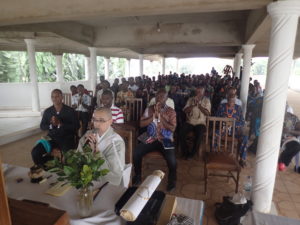
During these shakubuku meetings that took place in Atakpamé, Afagnan and Lomé, the Message of the Chief Priest Rev. Shindo Imafuku focused on “The Four and Eight Sufferings” Through this Message, Rev made us understand that we live in a world of suffering. A strong person will use the eight (8) sufferings as a source of power to build a truly happy life. But how do you become a strong person? Only by chanting Nam Myoho Renge Kyo day and night. A weak person considers suffering as a misfortune which should be avoided.
Some of the questions which asked at the meetings are as follows:
- Is Nam Myoho Renge Kyo the solution to the suffering caused by juju?
- At each determination in faith for 2 or 3 months, I fall seriously ill and I give up the practice. What can I do?
- Is suffering an entity?
- How to ensure our reincarnation as Nichiren Shoshu member?
- Can we do Gongyo in other languages?
- How to explain the suffering of birth?
- Speaking of life force, we will not get sick anymore?
- Is the vision of Buddhism different from other religions?
- Why is Buddhism better than other religions?
- The meaning of Shodai?

Responding to these questions, the Chief Priest had repeatedly returned to the importance of the law of cause and effect as taught by Buddhism. According to him, those who do not know the Daishonin Buddhism usually try to escape from suffering or overcome it by using their own strategies. People are trying to cope with suffering in many ways. However, no one can solve the root cause of the sufferings of life with the wisdom of an ordinary mortal. We should know that the supreme way to properly resolve anxiety and hardship is to practice the faith of Daishonin Buddhism.
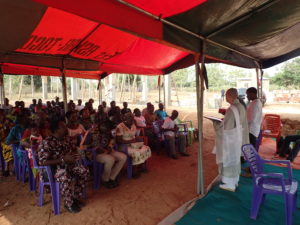
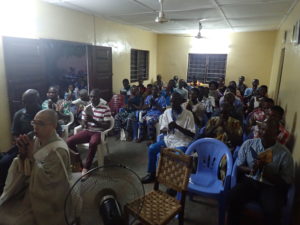
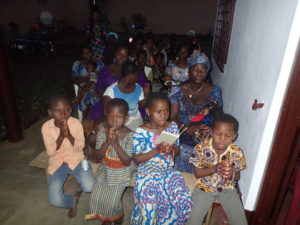
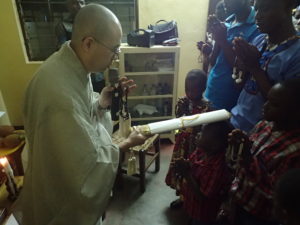

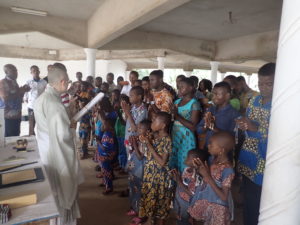
Gojukai at Afagnan
